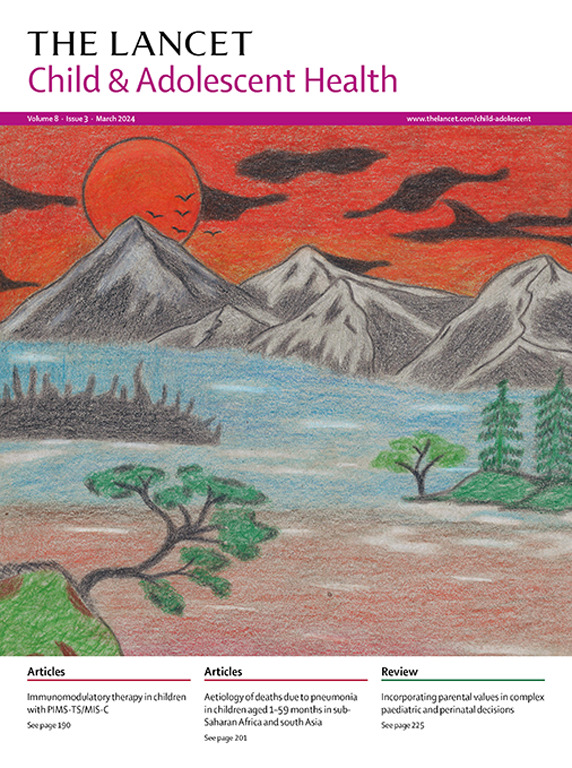Comparison of dengue, chikungunya, and Zika among children in Nicaragua across 18 years: a single-centre, prospective cohort study
IF 15.5
1区 医学
Q1 PEDIATRICS
引用次数: 0
Abstract
Background
Dengue, chikungunya, and Zika are diseases of major human concern. Differential diagnosis of these three diseases is complicated in children and adolescents due to overlapping clinical features (signs, symptoms, and complete blood count results). Few studies have directly compared these three diseases. We aimed to use 18 years of primary care observations from a paediatric cohort to characterise the distinguishing features of dengue, chikungunya, and Zika.
Methods
This single-centre prospective cohort study was based on the ongoing Pediatric Dengue Cohort Study (PDCS), which started on Aug 30, 2004, in District II of Managua, Nicaragua. The PDCS was initiated to study dengue virus infections in children who attended the Health Center Sócrates Flores Vivas (HCSFV) for their medical needs; over the years, the PDCS expanded the age range (2 to <10 years expanded to 2 to <18 years). The PDCS also expanded eligibility criteria to include chikungunya virus and Zika virus before they entered the geographical study area in August, 2014 and January, 2016, respectively. For this study, we included laboratory confirmed cases of dengue, chikungunya, and Zika enrolled in the PDCS between Jan 19, 2006, and Dec 31, 2023, and evaluated at the HCSFV. We assessed clinical features (clinical records and laboratory results) during the first 10 days of illness using generalised additive models, day-specific and disease-specific prevalence estimates, and machine learning models.
Findings
We characterised 1405 dengue, 517 chikungunya, and 522 Zika cases. The median age was 10·0 years (IQR 7·0–12·7); 1165 (47·7%) cases were male and 1279 (52·3%) were female. The prevalence of many clinical features shown by dengue, chikungunya, and Zika cases differed substantially overall, by age, and by day of illness. The presence of basophilia (prevalence difference 42·3% [95% CI 37·4 to 47·0]), monocytopenia (13·0% [10·0 to 16·4]), abdominal pain (19·1% [15·7 to 22·9]), and leukopenia (41·1% [36·2 to 45·6]) best distinguished dengue; the presence of arthralgia (60·5% [56·3 to 64·2]) and absence of papular rash (–14·9% [–17·2 to –12·7]), leukopenia (–32·0% [–36·7 to –27·1]), and conjunctival injection (–4·9% [–6·6 to –3·3]) best distinguished chikungunya; and the presence of generalised rash (35·0% [30·1 to 39·7]) and absence of fever (–37·3% [–41·7 to –33·0]), headache (–36·2% [–41·1 to –31·2]), myalgia (–30·1% [–33·9 to –26·2]), and lymphocytopenia (–41·9% [–46·6 to –37·1]) best distinguished Zika. Dengue and chikungunya cases showed similar temperature dynamics during acute illness, and their mean temperatures were higher than Zika cases. 62 laboratory confirmed afebrile dengue cases, which would not be captured by any widely used international case definition, presented most similarly to afebrile Zika cases, but five (8·1%) had warning signs of dengue disease severity. Based on boosted regression tree models, the presence of arthralgia and absence of basophilia and leukopenia most distinguished chikungunya, the presence of basophilia and leukopenia most distinguished dengue, and the absence of fever most distinguished Zika.
Interpretations
These findings substantially update the understanding of dengue, chikungunya, and Zika in a paediatric population and identify various clinical features that could improve differential diagnoses. The occurrence of afebrile dengue warrants reconsideration of current guidance.
Funding
US National Institutes of Health.
Translation
For the Spanish translation of the abstract see Supplementary Materials section.
尼加拉瓜18年来儿童登革热、基孔肯雅热和寨卡的比较:一项单中心前瞻性队列研究
登革热、基孔肯雅热和寨卡病毒是人类关注的主要疾病。在儿童和青少年中,由于临床特征(体征、症状和全血细胞计数结果)重叠,这三种疾病的鉴别诊断很复杂。很少有研究直接比较这三种疾病。我们的目的是利用来自一个儿科队列的18年初级保健观察来描述登革热、基孔肯雅热和寨卡的显著特征。方法本单中心前瞻性队列研究基于正在进行的儿科登革热队列研究(PDCS),该研究于2004年8月30日在尼加拉瓜马那瓜第二区开始。PDCS的启动是为了研究在Sócrates弗洛雷斯·维瓦斯保健中心(HCSFV)就诊的儿童的登革热病毒感染情况,以满足其医疗需求;多年来,PDCS扩大了年龄范围(2至10岁扩大到2至18岁)。PDCS还扩大了资格标准,包括分别于2014年8月和2016年1月进入地理研究区域之前的基孔肯雅病毒和寨卡病毒。在这项研究中,我们纳入了2006年1月19日至2023年12月31日期间在PDCS登记的登革热、基孔肯雅热和寨卡实验室确诊病例,并在HCSFV中进行了评估。我们使用广义加法模型、特定日期和特定疾病的患病率估计以及机器学习模型评估疾病前10天的临床特征(临床记录和实验室结果)。发现1405例登革热、517例基孔肯雅热和522例寨卡。中位年龄10.0岁(IQR 7.0 ~ 12.7);男性1165例(47.7%),女性1279例(52.3%)。登革热、基孔肯雅热和寨卡病毒病例所显示的许多临床特征的流行程度在总体上、年龄和发病天数上存在很大差异。嗜碱性粒细胞增多症(患病率差异42.3% [95% CI 37.4 ~ 47.0])、单核细胞减少症(13.0%[10.0 ~ 16.4])、腹痛(19.1%[15.7 ~ 22.9])和白细胞减少症(41.1%[36.2 ~ 45.6])是登革热的最佳诊断指标;表现为关节痛(60.5%[56.3 ~ 64.2])、无丘疹(- 14.9%[- 17.2 ~ - 12.7])、白细胞减少(- 32.0%[- 36.7 ~ - 27.1])和结膜注射(- 4.9%[- 6.6 ~ - 3.3])是基孔肯雅热的最佳诊断;出现全身性皮疹(35.0%[30.1 ~ 39.7])、无发热(- 37.3%[- 41.7 ~ - 33.0])、头痛(- 36.2%[- 41.1 ~ - 31.2])、肌痛(- 30.1%[- 33.9 ~ - 26.2])和淋巴细胞减少(- 41.9%[- 46.6 ~ - 37.1])是寨卡病毒的最佳特征。登革热和基孔肯雅热病例在急性发病期间表现出相似的温度动态,其平均温度高于寨卡病例。62例实验室确诊的发热性登革热病例(没有被任何广泛使用的国际病例定义所包括)的表现与发热性寨卡病例最为相似,但5例(8.1%)具有登革热严重程度的警告迹象。基于增强回归树模型,存在关节痛而没有嗜碱性粒细胞增多和白细胞减少症是基孔肯雅热的最显著特征,存在嗜碱性粒细胞增多和白细胞减少症是登革热的最显著特征,没有发烧是寨卡病毒的最显著特征。这些发现大大更新了对登革热、基孔肯雅热和寨卡在儿科人群中的认识,并确定了可以改善鉴别诊断的各种临床特征。发热性登革热的发生值得重新考虑目前的指南。资助美国国立卫生研究院。有关摘要的西班牙语翻译,请参阅补充资料部分。
本文章由计算机程序翻译,如有差异,请以英文原文为准。
求助全文
约1分钟内获得全文
求助全文
来源期刊

Lancet Child & Adolescent Health
Psychology-Developmental and Educational Psychology
CiteScore
40.90
自引率
0.80%
发文量
381
期刊介绍:
The Lancet Child & Adolescent Health, an independent journal with a global perspective and strong clinical focus, presents influential original research, authoritative reviews, and insightful opinion pieces to promote the health of children from fetal development through young adulthood.
This journal invite submissions that will directly impact clinical practice or child health across the disciplines of general paediatrics, adolescent medicine, or child development, and across all paediatric subspecialties including (but not limited to) allergy and immunology, cardiology, critical care, endocrinology, fetal and neonatal medicine, gastroenterology, haematology, hepatology and nutrition, infectious diseases, neurology, oncology, psychiatry, respiratory medicine, and surgery.
Content includes articles, reviews, viewpoints, clinical pictures, comments, and correspondence, along with series and commissions aimed at driving positive change in clinical practice and health policy in child and adolescent health.
 求助内容:
求助内容: 应助结果提醒方式:
应助结果提醒方式:


